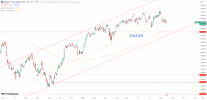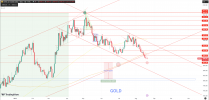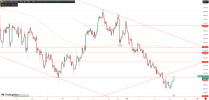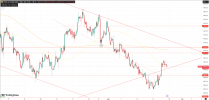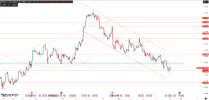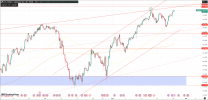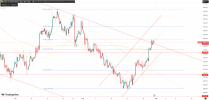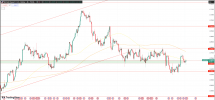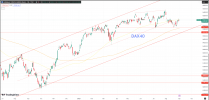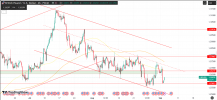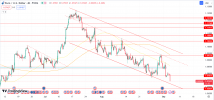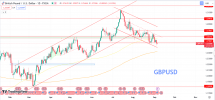 EURUSD
EURUSDItaly's recent announcement of a windfall tax targeting its lenders led to a sharp decline in banking stocks. However, the situation took a turn on Wednesday after the government clarified that the 40% tax wouldn't exceed 0.1% of the bank's total assets. Meanwhile, the European Central Bank (ECB) is set to release its economic bulletin, and Italy is scheduled to publish the final July inflation figures.
Currently, market participants are in a state of anticipation, awaiting the release of the US July Consumer Price Index report on Thursday. The anticipated annual CPI rate is 3.3%, up from June's 3%. Additionally, the weekly Jobless Claims report is also on the horizon. These figures are highly anticipated and could potentially trigger significant movements in the market.
The EUR/USD price action indicates a double bottom, suggesting uncertainty regarding the current level and clustering of prices at this point. The upcoming support levels are situated at 1.0920 and 1.0850. Furthermore, the 100MA on the daily chart is providing support at the present levels.
Currently, market participants are in a state of anticipation, awaiting the release of the US July Consumer Price Index report on Thursday. The anticipated annual CPI rate is 3.3%, up from June's 3%. Additionally, the weekly Jobless Claims report is also on the horizon. These figures are highly anticipated and could potentially trigger significant movements in the market.
The EUR/USD price action indicates a double bottom, suggesting uncertainty regarding the current level and clustering of prices at this point. The upcoming support levels are situated at 1.0920 and 1.0850. Furthermore, the 100MA on the daily chart is providing support at the present levels.
| Resistance 3 | Resistance 2 | Resistance 1 | Support 1 | Support 2 | Support 3 |
| 1.1090 | 1.1050 | 1.1000 | 1.0950 | 1.0900 | 1.0850 |
 GBPUSD
GBPUSDThe Financial Times reported UK Prime Minister Rishi Sunak's potential move to restrict investments in the Chinese tech sector, similar to Joe Biden's action. This is notable as Sunak seeks political support after recent by-election setbacks. The National Institute of Economic and Social Research (NIESR) indicated the UK's economy might recover to pre-pandemic levels by Q3 2024. NIESR also discussed recession risk, inflation expectations, and potential Bank of England actions. Market sentiment remains uncertain due to factors including US-China tension, global economic concerns, and central bank actions. Despite this, US stock futures and yields are improving, influenced by upcoming US data. The US Consumer Price Index's positive performance in July could ease concerns about the Federal Reserve's interest rate plans after disappointing Nonfarm Payrolls data.
The GBP/USD found support at the 1.2650 level and formed a pennant pattern while the next resistance level is at 1.2820 and the support will be again the 1.2650.
| Resistance 3 | Resistance 2 | Resistance 1 | Support 1 | Support 2 | Support 3 |
| 1.3220 | 1.3150 | 1.3000 | 1.2650 | 1.2600 | 1.2400 |
 JPYUSD
JPYUSD Japan's wholesale inflation rate has persistently declined for the seventh consecutive month, reaching 3.6% currently, down from June's revised rate of 4.3%.
Surprising the markets, the Bank of Japan (BoJ) has made a minor adjustment to the Yield Curve Control (YCC) policy. Although the adjustment was modest, it has raised awareness among market participants about the potential for FX intervention if the yen continues to weaken.
The release of the US Consumer Price Index (CPI) holds significance. A CPI figure lower than expected could apply pressure on the USD/JPY pair, while a higher reading might reignite interest in levels beyond 145.000. However, traders above this threshold remain concerned about the possibility of BoJ intervention.
USDJPY hovering around the 144.00 resistance level waiting for today's big data. The next resistance will be the 145.00 level while the support is at 143.50.
Surprising the markets, the Bank of Japan (BoJ) has made a minor adjustment to the Yield Curve Control (YCC) policy. Although the adjustment was modest, it has raised awareness among market participants about the potential for FX intervention if the yen continues to weaken.
The release of the US Consumer Price Index (CPI) holds significance. A CPI figure lower than expected could apply pressure on the USD/JPY pair, while a higher reading might reignite interest in levels beyond 145.000. However, traders above this threshold remain concerned about the possibility of BoJ intervention.
USDJPY hovering around the 144.00 resistance level waiting for today's big data. The next resistance will be the 145.00 level while the support is at 143.50.
| Resistance 3 | Resistance 2 | Resistance 1 | Support 1 | Support 2 | Support 3 |
| 142.00 | 141.20 | 140.22 | 138.70 | 137.70 | 135.50 |
 XAUUSD
XAUUSDGold traders will keep an eye on the US Consumer Price Index (CPI) due later in the American session. The inflation figure is expected to rise from 3% to 3.3%, and the core inflation figure is expected to stay at 4.8%.
The recent commentary from Federal Reserve (Fed) speakers indicated that the Fed's stance has shifted from additional rate hikes to holding rates steady. The Philadelphia Fed president, Patrick Harker, stated that the central bank can leave interest rates where they are. Meanwhile, Atlanta Fed president Raphael Bostic states that no further rate hikes are necessary. Market players anticipated that the Fed would be less hawkish in the September meeting. The prospects of the end of the tightening policy by the Fed might cap the upside in the USD and could act as a tailwind for the XAU/USD.
That said, the concern about the economic slowdown in China exerts pressure on the gold price as China is the major gold consumer in the world. The Chinese inflation data on Wednesday showed the Consumer Price Index (CPI) YoY fell 0.3% in July from 0% prior, and the market consensus anticipated a -0.4% decline. Meanwhile, the Producer Price Index (PPI) declined 4.4% YoY, compared to the 4.1% drop expected and a 5.4% decline prior.
Looking ahead, the US Consumer Price Index (CPI) report will have a significant impact on the Federal Reserve's (Fed) future rate hike path and help investors determine the direction of XAU/USD
Gold continues to decline, following a bearish trend where the price is trading above the median line. The median line has been acting as a support level for the past three instances of lower lows in price movements.
The recent commentary from Federal Reserve (Fed) speakers indicated that the Fed's stance has shifted from additional rate hikes to holding rates steady. The Philadelphia Fed president, Patrick Harker, stated that the central bank can leave interest rates where they are. Meanwhile, Atlanta Fed president Raphael Bostic states that no further rate hikes are necessary. Market players anticipated that the Fed would be less hawkish in the September meeting. The prospects of the end of the tightening policy by the Fed might cap the upside in the USD and could act as a tailwind for the XAU/USD.
That said, the concern about the economic slowdown in China exerts pressure on the gold price as China is the major gold consumer in the world. The Chinese inflation data on Wednesday showed the Consumer Price Index (CPI) YoY fell 0.3% in July from 0% prior, and the market consensus anticipated a -0.4% decline. Meanwhile, the Producer Price Index (PPI) declined 4.4% YoY, compared to the 4.1% drop expected and a 5.4% decline prior.
Looking ahead, the US Consumer Price Index (CPI) report will have a significant impact on the Federal Reserve's (Fed) future rate hike path and help investors determine the direction of XAU/USD
Gold continues to decline, following a bearish trend where the price is trading above the median line. The median line has been acting as a support level for the past three instances of lower lows in price movements.
| Resistance 3 | Resistance 2 | Resistance 1 | Support 1 | Support 2 | Support 3 |
| 1960 | 1953 | 1942 | 1931 | 1920 | 1900 |
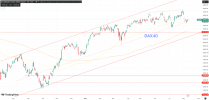 DAX40
DAX40European shares began the session on a positive note, with luxury stocks leading the way. This was especially evident after China lifted its ban on group tours in the United States and other significant markets. The STOXX Europe Luxury (.STXLUXP) index saw a rise of 1.6%, and heavyweight LVMH (.LVMH) experienced a notable surge of up to 2.7% during early trading. Hoteliers and airlines, including IHG and Air France (AF), also saw gains. Additionally, insurers (.SXIP) showed strength following positive performance numbers from Allianz (ALV) and Zurich (ZURN), contributing to the 0.5% increase in the STOXX Europe 600 (SXXP).
Paris, where LVMH is headquartered, stood out with the CAC 40 (PX1) index rising by 1.1%. Real estate stocks (.SX86P) also performed well, marking an increase of 1.8%. However, Novo Nordisk (NOVO_B) experienced a 1% decline after a significant surge earlier in the week due to positive news about its Wegovy drug.
DAX is rebounding from the 15800-support level and is now facing the next challenge at the 16000 short-term resistance level. The long bullish trend is evident, but it is currently forming reversal patterns as the price range in the last 3 months indicates weakness in the current trend.
Paris, where LVMH is headquartered, stood out with the CAC 40 (PX1) index rising by 1.1%. Real estate stocks (.SX86P) also performed well, marking an increase of 1.8%. However, Novo Nordisk (NOVO_B) experienced a 1% decline after a significant surge earlier in the week due to positive news about its Wegovy drug.
DAX is rebounding from the 15800-support level and is now facing the next challenge at the 16000 short-term resistance level. The long bullish trend is evident, but it is currently forming reversal patterns as the price range in the last 3 months indicates weakness in the current trend.
| Resi Level 3 | Resi Level 2 | Resi Level 1 | Suppo level 1 | Suppo level 2 | Suppo level 3 |
| 16600 | 16400 | 16200 | 15650 | 15400 | 15200 |


























